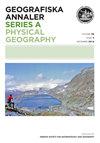The roles of agriculture and climate in land degradation in southeast Iceland AD 1700–1900
IF 1.8
4区 地球科学
Q3 GEOGRAPHY, PHYSICAL
Geografiska Annaler Series A-Physical Geography
Pub Date : 2020-09-14
DOI:10.1080/04353676.2020.1813985
引用次数: 3
Abstract
ABSTRACT Past human land-use is increasingly recognized as a driver of ecosystem change in seemingly natural landscapes. Quantification of historical land use is therefore critical for assessing the degree of human impact and requires integration of geography, ecology and history. This paper examines the impact of climate change, land-use and exposure to international markets on the terrestrial ecology in Suðursveit, in southeast Iceland between AD 1700 and 1901. For this we use historical data concerning land-use, livestock and demography, and mapping of glacier advance, glacier outburst floods (jökulhlaups) and agricultural land. Change in land-use or population during the eighteenth century was insignificant. Population declined in the first two decades of the nineteenth century due to the advance of Breiðamerkurjökull glacier. After AD 1820, Suðursveit became part of international market for agricultural products, which facilitated population and livestock increase. This led to overgrazing and severe land degradation in the nineteenth century.公元1700-1900年冰岛东南部农业和气候在土地退化中的作用
过去的人类土地利用越来越被认为是自然景观生态系统变化的驱动因素。因此,量化历史上的土地利用对于评估人类影响的程度至关重要,需要将地理、生态和历史结合起来。本文研究了公元1700年至1901年间,气候变化、土地利用和对国际市场的暴露对冰岛东南部su - ursveit陆地生态的影响。为此,我们使用了有关土地利用、牲畜和人口统计的历史数据,以及冰川推进、冰川溃决洪水(jökulhlaups)和农业用地的地图。18世纪土地利用和人口的变化微不足道。由于Breiðamerkurjökull冰川的推进,人口在19世纪头20年下降。公元1820年以后,苏ðursveit成为国际农产品市场的一部分,促进了人口和牲畜的增长。这导致了19世纪的过度放牧和严重的土地退化。
本文章由计算机程序翻译,如有差异,请以英文原文为准。
求助全文
约1分钟内获得全文
求助全文
来源期刊
CiteScore
3.60
自引率
0.00%
发文量
12
审稿时长
>12 weeks
期刊介绍:
Geografiska Annaler: Series A, Physical Geography publishes original research in the field of Physical Geography with special emphasis on cold regions/high latitude, high altitude processes, landforms and environmental change, past, present and future.
The journal primarily promotes dissemination of regular research by publishing research-based articles. The journal also publishes thematic issues where collections of articles around a specific themes are gathered. Such themes are determined by the Editors upon request. Finally the journal wishes to promote knowledge and understanding of topics in Physical Geography, their origin, development and current standing through invited review articles.

 求助内容:
求助内容: 应助结果提醒方式:
应助结果提醒方式:


